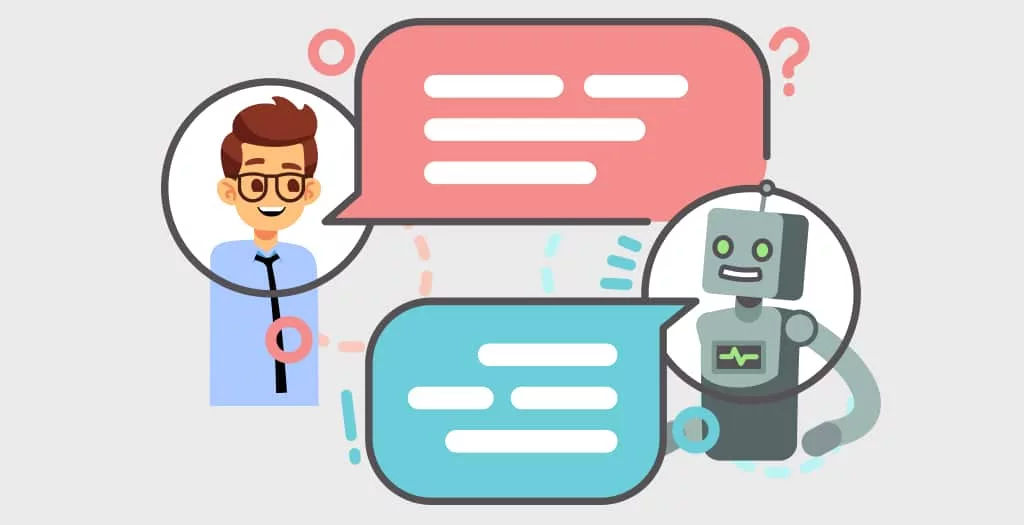SHARE

7 Simple Ways to Totally Rock Your AI Chatbot
When it comes to using and leveraging technology, businesses are constantly awaiting “the next big thing” when it comes to advancements so they can stimulate more growth and lead in the marketplace and this could not be more true than in the artificial intelligence space.
We are clearly still in the artificial intelligence (AI) infancy. Many of us are attempting to improve technology and comprehend what works for our online audiences. However, there is no need to wait for AI to reach its apex before deploying chatbots for your business.
AI chatbots are generating impressive results with companies already employing them as a central feature of their customer relations initiatives.
Consider these figures that speak to powerful results with AI Chatbots when integrated into customer support programs:
- Rodgers Wireless had a 60 percent improvement in customer service satisfaction.
- Marriott use of chatbot services has grown 85 percent month over month, since the technology was launched via Facebook Messenger.
- Swedbank chatbot, Nina, handles 40,000 conversations a month and resolves 81 percent of the issues.
More and more businesses are beginning to get value out of using chatbots. Companies like JPMorgan Chase, Bank of America, Marriott, and Coca-Cola are starting to see remarkable returns.
Companies are saving as much as 30 percent on customer service by deploying bots, according to IBM. BI Intelligence estimates that chatbots will produce $23 billion in savings from annual salaries. What’s more, companies can automate 36 percent of sales representative positions, resulting in total annual estimated savings of at least $15 billion from salaries.
What Are AI Chatbots?
A chatbot is an online instant messaging tool that is programmed to interact conversationally with people and perform certain tasks. Chatbots act as automated virtual assistants, capable of communicating with people through text messages on instant messaging platforms, forums, and onsite live chat apps.
In essence, chatbots are a popular way to allow customers to interact with your company on their own terms without being bogged down with numerous steps to get their issues resolved, or waiting for a human to reply to a message. All of this makes AI chatbots a powerful marketing tool.
A web-based messaging tool, basic chatbots usually respond to two types of events:
First interaction: A chatbot is used to welcome new visitors. It does this by sending an initial message. The bot is able to frame what it does for the visitor to your website – offer to answer questions, direct visitors in a specific direction, and let visitors know what the bot (or business) can do.
User Message: The visitor is also able to transmit messages to your business or organization using the chatbot. The visitor’s message is typically processed with natural language processing or keyword detection to understand the user’s intent and route the conversation accordingly.
7 Ways to Successful Build & Integrate Your Chatbot Program
1) Understand Your Metrics
Get to know the term “containment rate” – the percentage of total conversations completely handled by the bot. Its alternative name, “deflection rate”, is a vital metric to monitor when attempting to evaluate how your bot is performing. Always measure the effectiveness of your chatbot to the overall customer satisfaction for your business.
Be aware of how the implementation of a digital assistant might impact existing performance indicators. By having a chatbot, you could potentially free up your agents to focus on more complex customer inquiries. A well-defined chatbot program allows you to enjoy heightened customer satisfaction while having the added benefit of strengthening your bottom line.
2) Start with Hello
Have your initial bot operate in a simple, straightforward manner. When you launch your bot, choose a couple of basic, and useful, use cases to automate. Create iterations as you develop and build out your automated response program.
3) Leverage Your Agent
You should not develop your chatbot program in a vacuum. Be sure to engage your current front-line customer service team and solicit their ideas and input when designing an automated conversational experience. You’ll find success when you maintain the right balance between gathering helpful data and prevailing user experience research and listening to your entire customer service team.
4) Templates, Rules, and Machine Learning
It’s helpful to keep in mind that not all chatbots are “conversational AI”, as not all customer cases require machine learning. You’re bound to realize that your more effective bots can leverage rules and basic conditional logic. It simply depends on the nature of each customer interaction. We suggest leveraging buttons, quick replies, and other conversational templates that help the user proceed through the conversation quickly and efficiently.
5) Know When to Handover
Remember, that a chatbot is not meant to replace a human agent. There will be occasions when you provide a pathway for the user to extricate out of challenging conversations and difficult questions. Chatbots are specially designed to fully resolve low-level inquiries. However, even for more complex customer interactions, your chatbot can still be useful in gathering information and basic triage before you transfer the customer to a live agent. Chatbots are ideal for decreasing handle time and accelerating the customer’s support request.
6) Automation Works in Other Areas of Customer Support
Chatbots are most associated with automation. This leads to thoughts of intelligent customer service. However, there are other ways you can streamline customer support with a bot, while leveraging more intelligent services. These include automatic tagging, routing, and prioritization for an agent, among others.
7) Always be Focused on the Customer
Ultimately, the success of your chatbot will be determined by how well it is aligned with your customer support apparatus, as well as the cadence strategy you have devised for your customers. Factor into your chatbot operation the preference of some customers for automation as opposed to the direct connection with a human. As you fine-tune the implementation of your chatbot program, you will discover wherein the customer support sequence it fits best.
you may also like
5 Signs It’s Time to Switch: Upgrading from Shared to Dedicated Managed Cloud Hosting
In the digital age, a strong online presence is crucial for businesses aiming to thrive and expand….
The Power of Storytelling in Web Design
In the digital age, where countless websites vying for attention, storytelling in web design has emerged as…
The Secret to Successful Company Growth
We're determined to help your company grow by providing a solid marketing foundation and all the tools you need to accellerate your growth, from your website to your online and offline marketing strategies.
Download Our Guide
You have a great company, all the expertise you can possible attain in your industy, and you offer an excellent service.
Now for the age-old question...




